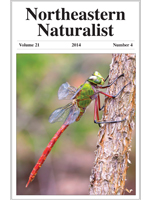We studied the distribution and food sources of larval Petromyzon marinus (Sea Lamprey) in the Hudson River basin, NY, and found ammocoetes of Sea Lampreys in four tributaries of the Hudson River: 1) Cedar Pond Brook, 2) Catskill Creek, 3) Roeliff Jansen Kill, and 4) Rondout Creek. The largest numbers of Sea Lampreys in the Hudson River basin appears to come from Catskill Creek. Sea Lampreys could increase their range in the Hudson River basin in the near future as barriers to migration are removed. Isotopic analysis demonstrated that Sea Lamprey larvae depended on both terrestrial plant material (i.e., allochthonous) and aquatic primary production (i.e., autochthonous), but that site characteristics influenced the importance of each to nutrition. Larval lampreys from the Kaaterskill Creek depended on allochthonous sources for about half of their nutrition, while those at Cedar Pond Brook obtained only ∼1% of their nutrition from these same sources. Gut contents of larval Sea Lampreys were isotopically distinct from filter-feeding macroinvertebrates, suggesting that they exploit food resources differently.
How to translate text using browser tools
1 March 2015
The Distribution of Larval Sea Lampreys, Petromyzon marinus, and Their Nutritional Sources in the Hudson River Basin
Thomas M. Evans,
Karin E. Limburg
ACCESS THE FULL ARTICLE

Northeastern Naturalist
Vol. 22 • No. 1
March 2015
Vol. 22 • No. 1
March 2015




